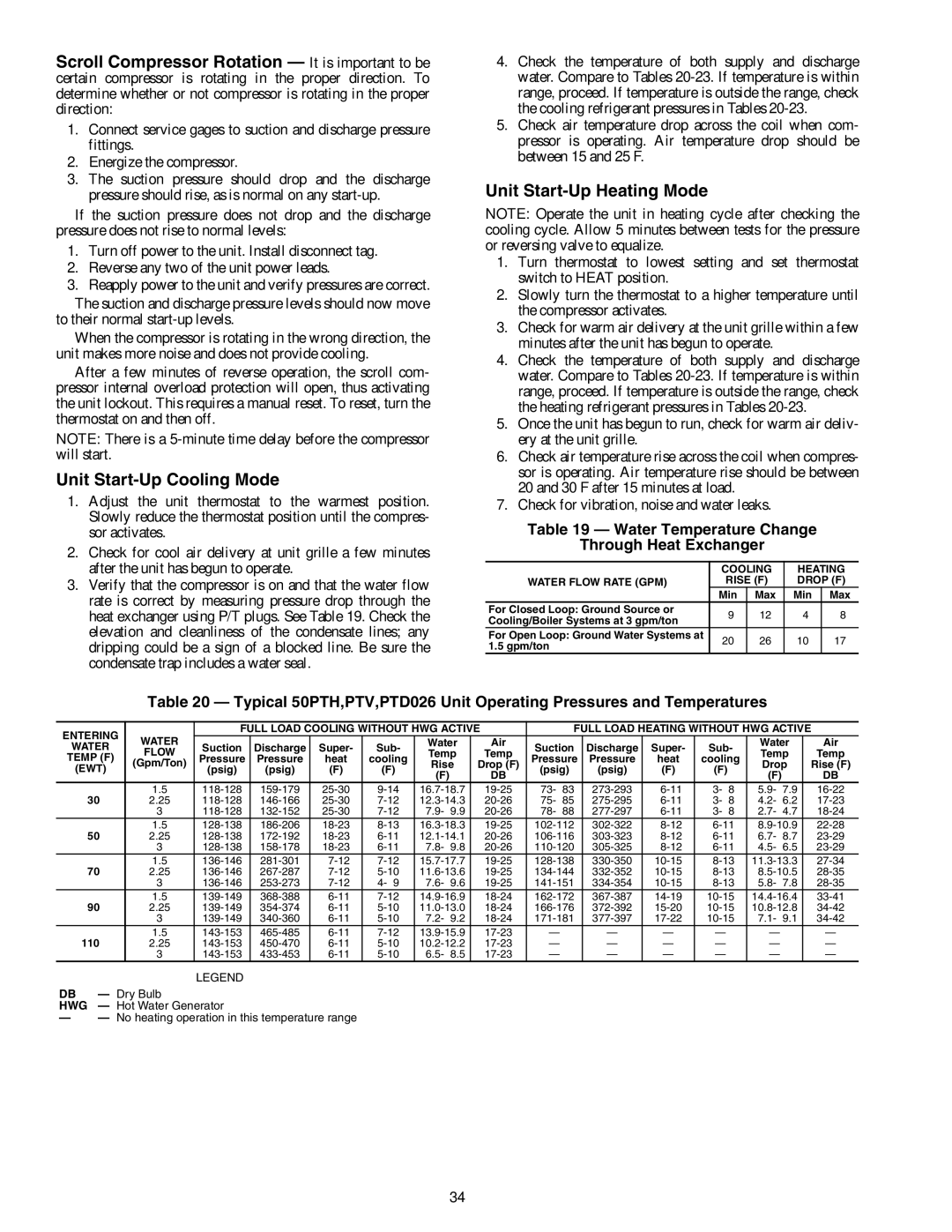Scroll Compressor Rotation — It is important to be certain compressor is rotating in the proper direction. To determine whether or not compressor is rotating in the proper direction:
1.Connect service gages to suction and discharge pressure fittings.
2.Energize the compressor.
3.The suction pressure should drop and the discharge pressure should rise, as is normal on any
If the suction pressure does not drop and the discharge pressure does not rise to normal levels:
1.Turn off power to the unit. Install disconnect tag.
2.Reverse any two of the unit power leads.
3.Reapply power to the unit and verify pressures are correct.
The suction and discharge pressure levels should now move to their normal
When the compressor is rotating in the wrong direction, the unit makes more noise and does not provide cooling.
After a few minutes of reverse operation, the scroll com- pressor internal overload protection will open, thus activating the unit lockout. This requires a manual reset. To reset, turn the thermostat on and then off.
NOTE: There is a
Unit Start-Up Cooling Mode
1.Adjust the unit thermostat to the warmest position. Slowly reduce the thermostat position until the compres- sor activates.
2.Check for cool air delivery at unit grille a few minutes after the unit has begun to operate.
3.Verify that the compressor is on and that the water flow rate is correct by measuring pressure drop through the heat exchanger using P/T plugs. See Table 19. Check the elevation and cleanliness of the condensate lines; any dripping could be a sign of a blocked line. Be sure the condensate trap includes a water seal.
4.Check the temperature of both supply and discharge water. Compare to Tables
5.Check air temperature drop across the coil when com- pressor is operating. Air temperature drop should be between 15 and 25 F.
Unit Start-Up Heating Mode
NOTE: Operate the unit in heating cycle after checking the cooling cycle. Allow 5 minutes between tests for the pressure or reversing valve to equalize.
1.Turn thermostat to lowest setting and set thermostat switch to HEAT position.
2.Slowly turn the thermostat to a higher temperature until the compressor activates.
3.Check for warm air delivery at the unit grille within a few minutes after the unit has begun to operate.
4.Check the temperature of both supply and discharge water. Compare to Tables
5.Once the unit has begun to run, check for warm air deliv- ery at the unit grille.
6.Check air temperature rise across the coil when compres- sor is operating. Air temperature rise should be between 20 and 30 F after 15 minutes at load.
7.Check for vibration, noise and water leaks.
Table 19 — Water Temperature Change
Through Heat Exchanger
| COOLING | HEATING | |||
WATER FLOW RATE (GPM) | RISE (F) | DROP (F) | |||
| Min | Max | Min | Max | |
For Closed Loop: Ground Source or | 9 | 12 | 4 | 8 | |
Cooling/Boiler Systems at 3 gpm/ton | |||||
|
|
|
| ||
For Open Loop: Ground Water Systems at | 20 | 26 | 10 | 17 | |
1.5 gpm/ton | |||||
|
|
|
| ||
Table 20 — Typical 50PTH,PTV,PTD026 Unit Operating Pressures and Temperatures
ENTERING | WATER | FULL LOAD COOLING WITHOUT HWG ACTIVE |
| FULL LOAD HEATING WITHOUT HWG ACTIVE | ||||||||||||||
WATER | Suction | Discharge | Super- | Sub- | Water | Air | Suction | Discharge | Super- | Sub- | Water | Air | ||||||
FLOW | Temp | Temp | Temp | Temp | ||||||||||||||
TEMP (F) | Pressure | Pressure | heat | cooling | Pressure | Pressure | heat | cooling | ||||||||||
(Gpm/Ton) | Rise | Drop (F) | Drop | Rise (F) | ||||||||||||||
(EWT) |
| (psig) | (psig) | (F) | (F) | (F) | DB | (psig) | (psig) | (F) | (F) |
| (F) |
| DB | |||
|
|
|
|
|
|
|
|
|
|
|
|
|
| |||||
| 30 | 1.5 | 73- | 83 | 3- | 8 | 5.9- | 7.9 | ||||||||||
| 2.25 | 75- | 85 | 3- | 8 | 4.2- | 6.2 | |||||||||||
|
| 3 | 7.9- 9.9 | 78- | 88 | 3- | 8 | 2.7- | 4.7 | |||||||||
| 50 | 1.5 | ||||||||||||||||
| 2.25 | 6.7- | 8.7 | |||||||||||||||
|
| 3 | 7.8- 9.8 | 4.5- | 6.5 | |||||||||||||
| 70 | 1.5 | ||||||||||||||||
| 2.25 | |||||||||||||||||
|
| 3 | 4- 9 | 7.6- 9.6 | 5.8- | 7.8 | ||||||||||||
| 90 | 1.5 | ||||||||||||||||
| 2.25 | |||||||||||||||||
|
| 3 | 7.2- 9.2 | 7.1- | 9.1 | |||||||||||||
| 110 | 1.5 | — |
| — | — | — |
| — |
| — | |||||||
| 2.25 | — |
| — | — | — |
| — |
| — | ||||||||
|
| 3 | 6.5- 8.5 | — |
| — | — | — |
| — |
| — | ||||||
|
|
| LEGEND |
|
|
|
|
|
|
|
|
|
|
|
|
|
| |
DB | — Dry Bulb |
|
|
|
|
|
|
|
|
|
|
|
|
|
|
| ||
HWG — Hot Water Generator |
|
|
|
|
|
|
|
|
|
|
|
|
|
| ||||
—— No heating operation in this temperature range
34
